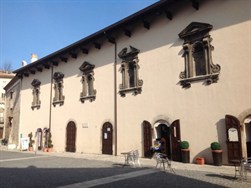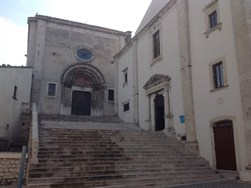Pescocostanzo
 Pescocostanzo, another of the borghi più belli d’Italia, can be considered the principal centre of the Baroque in Abruzzo. In fact, its interior perfectly conserves a rich heritage of monuments of the Renaissance and Baroque period, within an urban layout which has remained virtually unchanged for centuries. Various Lombard masters were at work in Pescocostanzo, between the fifteenth and the eighteenth centuries, attracted by the patronage of well to do members of society. Among the great artists who worked there, if only for brief stints, was the architect Cosimo Fanzago, whose influence is evident in the church of Gesù e Maria. The Fanzago palace was projected by him in the twenties of the seventeenth century and used by the same cloistered convent by the religious of Santa Scolastica. The peculiarity of the facade (photo 1) lies in six great stone niches, surmounted by timpana which are alternatively whole and fractured, which substitute windows, which are impossibile on account of the cloister.
Pescocostanzo, another of the borghi più belli d’Italia, can be considered the principal centre of the Baroque in Abruzzo. In fact, its interior perfectly conserves a rich heritage of monuments of the Renaissance and Baroque period, within an urban layout which has remained virtually unchanged for centuries. Various Lombard masters were at work in Pescocostanzo, between the fifteenth and the eighteenth centuries, attracted by the patronage of well to do members of society. Among the great artists who worked there, if only for brief stints, was the architect Cosimo Fanzago, whose influence is evident in the church of Gesù e Maria. The Fanzago palace was projected by him in the twenties of the seventeenth century and used by the same cloistered convent by the religious of Santa Scolastica. The peculiarity of the facade (photo 1) lies in six great stone niches, surmounted by timpana which are alternatively whole and fractured, which substitute windows, which are impossibile on account of the cloister.
 Nonetheless, the main symbol of the flourishing past of Pescocostanzo is the Basilica of Santa Maria del Colle (photo 2). The inside is divided in five naves, richly decorated in marble, stone and iron and finely elaborated wood. Of particular interest are the panelled ceilings, also in wood, in which several important paintings are mounted. Among them, Sacra Famiglia (Holy Family) by Francesco Peresi, dated 1708 stands out and it must be considered the first work by the Neapolitan artist to reach us. The Madonna dell’incendio sedato (The Madonna who extinguishes the fire) was the fruit of the artistic genius of Tanzio da VaralloAntonio d’Enrico, called Tanzio da Varallo (1575 ca.-1633) was one of the most representative painters of Counter Reformation art. During his Roman apprenticeship he was able to know and appreciate the art of Caravaggio. Before returning to Valsesia he spent fifteen years away from his native land: in Rome, Naples and also in Abruzzo. The altarpiece with his Circoncisione which is found at Fara San Martino dates from that period in addition to the Madonna dell’incendio sedato (The Madonna who extinguishes the fire) at Pescocostanzo and the Madonna con Bambino (Madonna with child) in the sacristy of the parish of Colledimezzo., a painter who was active in the first half of the seventeenth century and who most certainly lived for a long time in Abruzzo. His presence has remained, through his paintings, in other places of worship in the region, such as the parish churches of Fara San MartinoFara San Martino is a city of about 1,500 inhabitants located in the current province of Chieti. The territory was colonized by Benedictine monks in the ninth and tenth centuries, becoming the fief of the Valignani family in the early modern period. The principal testimonies to its past are presented by architectural and sculptural fragments in the thirteenth century portal, in the frescoes of the abbey of San Martino and in a painting of Tarzio da Varallo, conserved in the parish church. and ColledimezzoA small town located in the current province of Chieti, Colledimezzo was founded around the tenth century. In the early modern period it was part of the country of Monteodorisio, a fied of the d’Avalos family. The principal church of the town is San Giovanni Evangelista e Apostolo. It has one nave, decorated by frescoes and paintings among which stand out the Madonna con Bambino (Madonna with child) by Tanzio da Varallo..
Nonetheless, the main symbol of the flourishing past of Pescocostanzo is the Basilica of Santa Maria del Colle (photo 2). The inside is divided in five naves, richly decorated in marble, stone and iron and finely elaborated wood. Of particular interest are the panelled ceilings, also in wood, in which several important paintings are mounted. Among them, Sacra Famiglia (Holy Family) by Francesco Peresi, dated 1708 stands out and it must be considered the first work by the Neapolitan artist to reach us. The Madonna dell’incendio sedato (The Madonna who extinguishes the fire) was the fruit of the artistic genius of Tanzio da VaralloAntonio d’Enrico, called Tanzio da Varallo (1575 ca.-1633) was one of the most representative painters of Counter Reformation art. During his Roman apprenticeship he was able to know and appreciate the art of Caravaggio. Before returning to Valsesia he spent fifteen years away from his native land: in Rome, Naples and also in Abruzzo. The altarpiece with his Circoncisione which is found at Fara San Martino dates from that period in addition to the Madonna dell’incendio sedato (The Madonna who extinguishes the fire) at Pescocostanzo and the Madonna con Bambino (Madonna with child) in the sacristy of the parish of Colledimezzo., a painter who was active in the first half of the seventeenth century and who most certainly lived for a long time in Abruzzo. His presence has remained, through his paintings, in other places of worship in the region, such as the parish churches of Fara San MartinoFara San Martino is a city of about 1,500 inhabitants located in the current province of Chieti. The territory was colonized by Benedictine monks in the ninth and tenth centuries, becoming the fief of the Valignani family in the early modern period. The principal testimonies to its past are presented by architectural and sculptural fragments in the thirteenth century portal, in the frescoes of the abbey of San Martino and in a painting of Tarzio da Varallo, conserved in the parish church. and ColledimezzoA small town located in the current province of Chieti, Colledimezzo was founded around the tenth century. In the early modern period it was part of the country of Monteodorisio, a fied of the d’Avalos family. The principal church of the town is San Giovanni Evangelista e Apostolo. It has one nave, decorated by frescoes and paintings among which stand out the Madonna con Bambino (Madonna with child) by Tanzio da Varallo..
